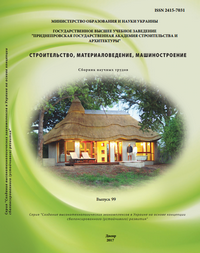Influence of technological factors on the polymerization processes in impregnated concrete josef
Keywords:
polymerization, vacuumizing, microwave drying.Abstract
Abstract: This article examines the influence of drying, vacuumizing and monomers polymerization on concrete strength in saturated concrete structures. There are different methods of drying concrete, such as: convective, radiation (including infrared), contact (preferably electric) and microwave (high-frequency). Impregnating monomers used for various purposes tasks to protect and enhance designs, longer service life. It was shown that the kinetics of strength growth and the stress deformation state of the concrete is complex and depends on many factors, including basic: the composition and type of cement, water-cement ratio, the rate of temperature increase, humidity and more. The modes and methods of concrete impregnating by monomers and polymers in view of the size of molecules injecting material and type of concrete are described. Of great interest is the partial or surface impregnation of concrete and reinforced concrete structures that serve to improve the filtration characteristics and corrosive resistance of material. The influence of temperature on polymerization and strength of structures and the impact of radiation polymerization of monomers in the body the strength of concrete structures. The attempt to build a mathematical model of the polymerization of monomer in the pores of the concrete. It is the process of polymerization in capillary-porous media is a process blokovoyiyi polymerization. It is shown that some of the problems of technological factors insufficiently studied.References
Akhverdov I.N., Smol'skiy A.E., Skochelyas V.V. Modelirovanie napryazhennogo sostoyaniya betona i zhelezobetona [Modeling of the stress state of concrete and reinforced concrete] – Minsk: Nauka i tekhnika, 1973. – 231 p.(in Russian).
Bazhenov Yu.M. Polimery v betone [Polymers in concrete] Perspektivy primeneniya betonopolimerov i polimerbetonov v stroitel'stve. – M.: Stroyizdat, 1976. (in Russian).
Likov A.V. Teoriya sushki [Drying theory] – M.: Energiya, 1968. – 472 p. (in Russian).
Marek O., Tomka M. Akrilovy polimery [Acrylic polymers] – M.;L.: Khimiya, 1966. – 318 p. (in Russian).
Marchyukaytis G.V., Dulinskas E.Yu. Napryazhenno-deformirovannoe sostoyanie prednapryazhennykh zhelezobetonnykh konstruktsiy pri teploobrabotke [Stress-deformation state of prestressed reinforced concrete structures during heat treatment] – Vil'nyus, 1975. – 123 p. (in Russian).
Perspektivy primeneniya betonopolimerov i polimerbetonov v stroitel'stve. [The use of concrete polymers and polymer concrete in construction] Tezisy dokladov Vsesoyuznogo simpoziuma – M.: Stroyizdat, 1976. (in Russian).
Popchenko S.N., Kudoyarov L.I. Zakonomernosti kapillyarnoy propitki poristykh kamney organicheskimi materialami [Capillary impregnation of porous stones with organic materials] Izv. VNIIG im. B.E. Vedeneeva. – 1972, T. 100. – pp. 166–179. (in Russian).
Radiatsionnaya khimiya polimerov [Radiation chemistry of polymers] Pod red. Kargina V.A. – M.: Nauka, 1973. (in Russian).
Ratinov V.B. Ivanov F.M. Khimiya v stroitel'stve [Chemistry in Construction]. – M.: Stroyizdat, 1977. – 220 p.
Savytskyi N.V., Khudalyi E.Yu., Borodin A.A., Tytiuk A.A., Batasheva K.V., Zinkevych A.N., Yurchenko E.P., Imashechkiv S.A. Otsinka stanu i rozrobka tekhnichnykh rishen po vidnovlenniu pratsezdatnoho stanu sylosiv [Assessment of the condition and development of technical solutions to restore the working condition of silos] Zbirn. nauk. pr. “Suchasni tekhnolohii diahnostyky remontu i vidnovlennia obiektiv budivnytstva i transportu”. – Dnipropetrovsk, 2003. – 284 p. (in Ukrainian).
Tager A.A. Fiziko-khimiya polimerov [Physicochemistry of polymers]. – M.: Khimiya, 1968. – 545 p. (in Russian).
Shiryaeva G.V., Raychuk F.Z., Tatarenko O.F. Primenenie ioniziruyushchego izlucheniya dlya polucheniya napolnennykh system [The use of ionizing radiation to produce filled systems] – ZhVKhO im. D.I. Mendeleeva, 1973 – T.28. – № 3. (in Russian).
Shumskiy K.P. Vakuumnye apparaty i pribory khimicheskogo mashinostroeniya [Vacuum apparatus and devices of chemical engineering]. – M.: Mashinostroenie, 1974. – 577 p. (in Russian).
Concrete-Polymer Materials. Brookhaven National Lab. Topical Reports I-V,N.Y., 1968–1973
Heins C.F. Ambitent pressure impregnation of concrete by low viscosity monomers./ C.F. Heins. - Amer.Chem.Soc.Polym.Prepr, 1973. – V.14. – N2.
Yong Ding. Copolymerization of Elemental Sulfur with Cyclic (Arylene Disulfide) Oligomers / Ding Yong, Hay S Allan // Department of Chemistry / McGill University, Canada, 1997.
Downloads
Published
Issue
Section
License
Редакція Видання категорично засуджує прояви плагіату в статтях та вживає всіх можливих заходів для його недопущення. Плагіат розглядається як форма порушення авторських прав і наукової етики.
При виявлені у статті більш ніж 25% запозиченого тексту без відповідних посилань та використання лапок, стаття кваліфікується як така, що містить плагіат. У цьому випадку стаття більше не розглядається редакцією, а автор отримує перше попередження.
Автори, в статтях яких повторно виявлено плагіат, не зможуть публікуватися в усіх журналах Видавництва ДВНЗ «Придніпровська державна академія будівництва та архітектури».
Автори, які публікуються у цьому журналі, погоджуються з наступними умовами:
- Автори залишають за собою право на авторство своєї роботи та передають журналу право першої публікації цієї роботи на умовах ліцензії Creative Commons Attribution License, котра дозволяє іншим особам вільно розповсюджувати опубліковану роботу з обов'язковим посиланням на авторів оригінальної роботи та першу публікацію роботи у цьому журналі.
- Автори мають право укладати самостійні додаткові угоди щодо неексклюзивного розповсюдження роботи у тому вигляді, в якому вона була опублікована цим журналом (наприклад, розміщувати роботу в електронному сховищі установи або публікувати у складі монографії), за умови збереження посилання на першу публікацію роботи у цьому журналі.
- Політика журналу дозволяє і заохочує розміщення авторами в мережі Інтернет (наприклад, у сховищах установ або на особистих веб-сайтах) рукопису роботи, як до подання цього рукопису до редакції, так і під час його редакційного опрацювання, оскільки це сприяє виникненню продуктивної наукової дискусії та позитивно позначається на оперативності та динаміці цитування опублікованої роботи (див. The Effect of Open Access).

